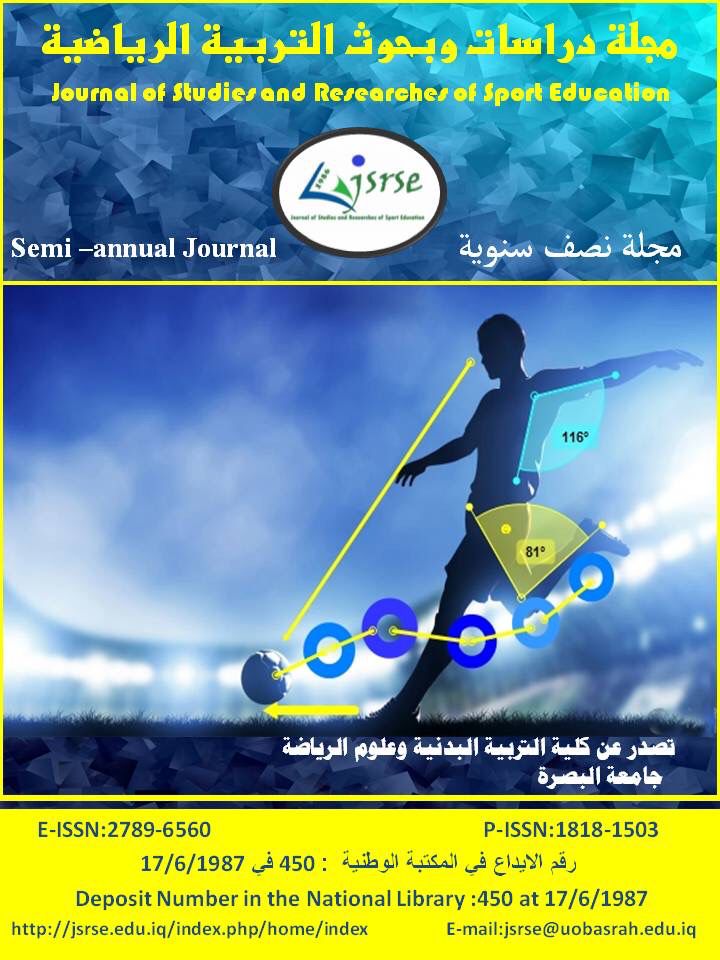تقيم العادات الغذائية وعلاقتها ببعض المتغيرات الفسيولوجية لدى مدرسي المدارس الإعدادية لمدينة سوران
محتوى المقالة الرئيسي
الملخص
كانت أهمية البحث في معرفة مستوى العادات الغذائية لدى مدرسي المدارس الإعدادية، وهدفت البحث إلى قياس العادات الغذائية لمدرسي مدراس في مدينة سوران ومعرفة نوع العلاقة بين العادات الغذائية وكل من المتغيرات الفسيولوجية قيد البحث وحسب الجنس، وتم اختيار عينة البحث الأصلية بالطريقة العمدية (المقصودة)، من مدارس الإعدادية لسنة الدراسية (2016-2017) في مدينة سوران، وعددهم (100) مدرساً ومدرسة تمثل نسبة مئوية قدرها (25%) من إجمالي مجتمع البحث والبالغ عددهم (393) تدريسياً. النتائج: كانت مستويات العادات الغذائية لعينة البحث ليس في مستوى المطلوب ولكن مقبول، وكانت مستوى العادات الغذائية لإناث أكبر من الذكور، وظهر علاقة عكسية ضعيفة بين مستويات العادات الغذائية وكل من (عدد ضربات القلب، وضغط الدم الانقباضي، وضغط الدم الانبساطي، وعدد مرات التنفس، والسعة الحيوية القسرية، ومؤشر كتلة الجسم).
تفاصيل المقالة

هذا العمل مرخص بموجب Creative Commons Attribution-NonCommercial 4.0 International License.
المراجع
AbdelFattah, A. aleula A. (2003). Training and sport physiology. dar alfikr alearabiu.
Al-Shawk, N. I., & Al-Kubaisi, R. S. F. (2004). Researcher’s guide to writing research in physical education. Baghdad University Press.
Al-Taalb, N., & Al-Saamaraayiy, M. (1985). Principles of statistics and mathematical physical tests. Mosul University, Dar Al-Kutub for printing and publishing.
Barzegari, A., Ebrahimi, M., Azizi, M., & Ranjbar, K. (2011). A study of nutrition knowledge, attitudes and food habits of college students. World Applied Sciences Journal , 15(7), 1012–1017. https://www.idosi.org/wasj/wasj15(7)11/16.pdf
Bouzidi, M. (2001a). Nutrition education and health prevention. Human Resources Directorate (Formation Strategies Section).
Bouzidi, M. (2001b). Nutritional education and health prevention (formulated for economic and frugal aides). Human Resources Directorate (Formation Strategies Section).
Deshmukh-Taskar, P. R., Nicklas, T. A., O’Neil, C. E., Keast, D. R., Radcliffe, J. D., & Cho, S. (2010). The relationship of breakfast skipping and type of breakfast consumption with nutrient intake and weight status in children and adolescents: The national health and nutrition examination survey 1999-2006. Journal of the American Dietetic Association, 110(6), 869–878. https://doi.org/10.1016/j.jada.2010.03.023
EL-Ridi, G. H., & Ali, M. H. (2018). Effect of some social and economic characteristics on rural food behavior case study of qoseer bkhanis village Qena governorate. The Egyptian Journal of Agricultural Economics, 28(2), 1003–1014. https://www.readcube.com/articles/10.21608%2Fmeae.2018.112032
Ezzal, Y. H. (2009). The effect of controlling breathing rate on some functional variables and the achievement of (50-100) meters freestyle swimming. Journal of Studies and Researches of Sport Education, 24.
Gomaa, S. A. (2000). Common dietary habits of some Egyptian and Saudi families and their impact on the nutritional status. Faculty of Specific Education - Ain Shams Univresity.
Hamulka, J., Wadolowska, L., Hoffmann, M., Kowalkowska, J., & Gutkowska, K. (2018). Effect of an education program on nutrition knowledge, attitudes toward nutrition, diet quality, lifestyle, and body composition in polish teenagers. the ABC of healthy eating project: design, protocol, and methodology. Nutrients, 10(10), 1439. https://doi.org/10.3390/nu10101439
HOELSCHER, D. M., EVANS, A., PARCEL, GUYS., & KELDER, STEVENH. (2002). Designing effective nutrition interventions for adolescents. Journal of the American Dietetic Association, 102(3), S52–S63. https://doi.org/10.1016/S0002-8223(02)90422-0
Hossam El-Din, L. A. (2004). The effectiveness of teaching a proposed unit based on constructivist theory to develop commercial secondary school students’ awareness of food education. Egyptian Journal of Scientific Education, 7(3), 660–711.
Ibrahim, M. A.-M. (2000). Descriptive and inferential statistics (1st ed.). Dar Al-Fikr for publication and distribution.
Khaled, Z. A., & Yahya, S. H. M. (2003). The effectiveness of a computer program in food culture on cognitive achievement and the development of food and health awareness among middle school students. Egyptian Journal of Scientific Education, 6(1), 37–84. https://fedu.stafpu.bu.edu.eg/Methodology/3007/publications/Said%20Hamed%20Mohamed%20Yehia_ddddddddd.doc
Muslim, A. J. (2005). A satudy of the relationship of some measurements of the heart muscle with some physiological variables of the circulatory system. Journal of Studies and Researches of Sport Education, 18.
Preedy, V. R., & Watson, R. R. (Eds.). (2010). Handbook of disease burdens and quality of life measures. Springer New York. https://doi.org/10.1007/978-0-387-78665-0
Ratib, O. K. (2004). Physical activity and relaxation - an approach to coping with stress and improving the quality of life. dar alfikr alearabiu.
Santich, B. (1994). Good for you: Beliefs about food and their relation to eating habits. Australian Journal of Nutrition and Dietetics, 51(2), 68–73.
Sjöberg, A., Hallberg, L., Höglund, D., & Hulthén, L. (2003). Meal pattern, food choice, nutrient intake and lifestyle factors in The Göteborg Adolescence Study. European Journal of Clinical Nutrition, 57(12), 1569–1578. https://doi.org/10.1038/sj.ejcn.1601726
Taylor, S. (2008). Health Psychology (1st ed.). Dar Al-Hamid for publication and distribution.





 IASJ
IASJ CC-BY-4.0
CC-BY-4.0 turnitin
turnitin ISSN
ISSN DOAJ
DOAJ Crossref
Crossref GoogleScholar
GoogleScholar Orcid
Orcid